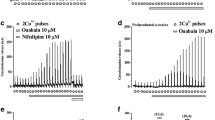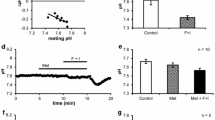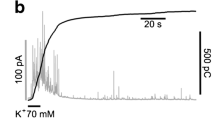Summary
-
1.
Cyclic AMP induces pronounced increases in ouabain binding and ouabain-sensitive oxygen consumption in rectal gland slices but does so in the absence of any change in the Na−K-ATPase activity of tissue homogenates. It is suggested that this apparent paradox results from the presence of inactive or concealed ‘latent sites’ in the membrane of the unstimulated gland which become exposed or activated in the presence of cAMP.
-
2.
Evidence suggests that, in the absence of cAMP, the exposure and activation of these latent sites is largely determined by the rate of sodium entry into the cells. It appears that sodium can enter the cells either by a simple passive diffusion down the electrochemical gradient or via a furosemide-sensitive, chloride-coupled pathway.
-
3.
Experiments have shown that the cAMP effect on ouabain binding and oxygen consumption is absent in conditions designed to eliminate the gradient for sodium entry into the cells. Similarly, no cAMP effect on these parameters is observed in the absence of external chloride or in the presence of furosemide. Furthermore, cAMP has been shown to produce a marked increase in sodium entry into the rectal gland cell and this enhanced entry is entirely furosemide-sensitive.
-
4.
It appears therefore that cAMP has no direct effect on the recruitment of latent sites per se but instead has a specific, stimulatory action on the furosemide-sensitive entry of sodium which, in turn, leads to an increase in functional sodium pump sites and an enhanced sodium efflux. Chloride efflux appears to be increased in a passive manner as a result of the increased gradient on this ion subsequent to an enhanced entry via the cAMP-stimulated, furosemide-sensitive pathway.
Similar content being viewed by others
References
Atkinson A, Gatenby AD, Lowe AG (1973) The determination of inorganic orthophosphate in biological systems. Biochim Biophys Acta 320:195–204
Burger JW (1962) Further studies on the function of the rectal gland in the spiny dogfish. Physiol Zool 35:205–217
Burger JW (1965) Roles of the rectal gland and the kidneys in salt and water excretion in the spiny dogfish. Physiol Zool 38:191–196
Eveloff J, Kinne R, Kinne-Saffran E, Murer H, Silva P, Epstein FH, Stoff J, Kinter WB (1978) Coupled sodium and chloride transport into plasma membrane vesicles prepared from dogfish rectal gland. Pflügers Arch 378:87–92
Eveloff J, Karnaky KJ Jr, Silva P, Epstein FH, Kinter WB (1979) Elasmobranch rectal gland cell: Autoradiographic localization of [3H] ouabain-sensitive Na−K-ATPase in rectal gland of dogfish,Squalus acanthias. J Cell Biol 83:16–32
Hansen O, Skou JC (1973) A study on the influence of the concentration of Mg2+, Pi, K+, Na+ and Tris on (Mg2++Pi)-supported g-strophanthin binding to (Na++K+)-activated ATPase from ox brain. Biochim Biophys Acta 311:51–66
Lowry OH, Rosebrough NJ, Farr AL, Randall RJ (1951) Protein measurement with the Folin phenol reagent. J Biol Chem 193:265–275
Shuttleworth TJ, Thompson JL (1978) Cyclic AMP and ouabain-binding sites in the rectal gland of the dogfishScyliorhinus canicula. J Exp Zool 206:297–302
Shuttleworth TJ, Thompson JL (1979a) Ion movements in the dogfish rectal gland — evidence for the independent uptake of sodium and chloride. Bull Mt Desert Isl Biol Lab 19:3–6
Shuttleworth TJ, Thompson JL (1979b) Ouabain-binding in the rectal gland ofSqualus — the effects of cyclic AMP, sodium and furosemide. Bull Mt Desert Isl Biol Lab 19:6–8
Shuttleworth TJ, Thompson JL (1980) Oxygen consumption in the rectal gland of the dogfishScyliorhinus canicula and the effects of cyclic AMP. J Comp Physiol 136:39–43
Silva P, Stoff J, Field M, Fine L, Forrest JN, Epstein FH (1977) Mechanism of active chloride secretion by shark rectal gland: role of Na−K-ATPase in chloride transport. Am J Physiol 233:298–306
Silva P, Baranano T, Epstein J, Stoff J, Epstein FH (1978) Na−K-ATPase and rectal gland secretion inSqualus acanthias. Bull Mt Desert Isl Biol Lab 18:16–19
Stoff JS, Silva P, Field M, Forrest J, Stevens A, Epstein FH (1977) Cyclic AMP regulation of active chloride transport in the rectal gland of marine elasmobranchs. J Exp Zool 199:443–448
Stoff JS, Rosa R, Hallac R, Silva P, Epstein FH (1979) Hormonal regulation of active chloride transport in the dogfish rectal gland. Am J Physiol 237:138–144
Author information
Authors and Affiliations
Rights and permissions
About this article
Cite this article
Shuttleworth, T.J., Thompson, J.L. The mechanism of cyclic AMP stimulation of secretion in the dogfish rectal gland. J Comp Physiol B 140, 209–216 (1980). https://doi.org/10.1007/BF00690405
Accepted:
Issue Date:
DOI: https://doi.org/10.1007/BF00690405




